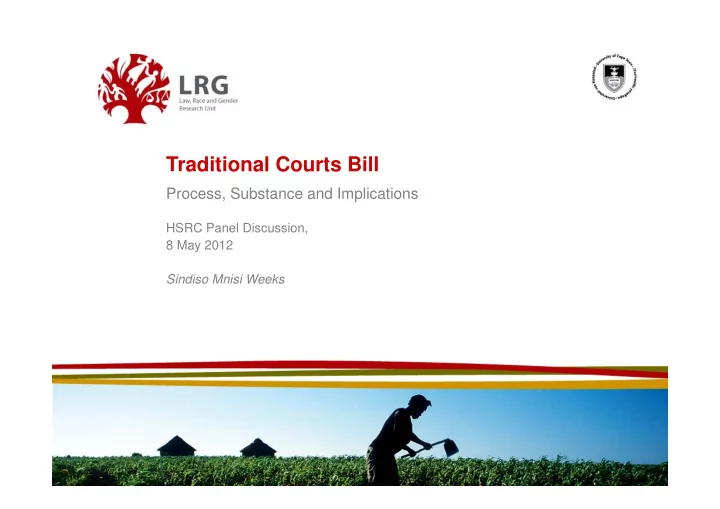

Traditional Courts Bill Process, Substance and Implications HSRC Panel Discussion, 8 May 2012 Sindiso Mnisi Weeks
Overview Traditional Courts Bill Background • Specific issues raised by the Bill and their implications • Centralisation of Power to Traditional Leader • Extensive Powers Assigned • Inescapable Apartheid ‘Tribal’ Boundaries • Women Not Afforded Adequate Protection •
Background and Process
• NA: B15-2008 – May 2008, public hearings – Outcry from civil society – Policy drafted in consultation with NHTL – No ordinary (rural) people consulted • NCOP: B1-2012 – Jan 2012, (re)introduced – Same (acknowledged) problems and concerns: Not enough for rural people to amend, not help conceptualise law
• SALRC research and consultation involving cross-section + special process with women by CALS, CGE and NLC • Findings: – Customary courts very important – 1927 Black Administration Act inadequate – Alignment of courts w/ Constitution necessary • Traditional leaders objected • SALRC recommendations disappeared
• Integral connection with Traditional Leadership and Governance Framework Act, 2003 (TLGFA) which is connected to Bantu Authorities Act, 1951 • Officially recognised senior traditional leaders become presiding officers of courts • Courts’ jurisdictions and boundaries the same as TLGFA boundaries
• Section 28(1) of the TLGFA: ‘Any traditional leader who was appointed as such in terms of applicable provincial legislation and was still recognised as a traditional leader immediately before the commencement of this Act, is deemed to have been recognised as such in terms of section 9 or 11 , subject to a decision of the Commission in terms of section 26.’ • Section 28(3): any ‘“ tribe ” that, immediately before the commencement of this Act, had been established and was still recognised as such is deemed to be a traditional community contemplated in section 2 ... .’ • Section 28(4): any ‘ tribal authority that, immediately before the commencement of this Act, had been established and was still recognised as such, is deemed to be a traditional council ...’ subject to elections of 40%.
Homelands 1986
Venda Gazankulu Lebowa KaNgwane KwaNdebele Bophuthatswana QwaQwa KwaZulu Traditional Transkei Councils 2010 Ciskei
Centralisation of Power to TL
• Presiding officer is senior traditional leader or his delegate • No functions, powers or recognition given to intrinsic role played by council or councillors in customary dispute resolution process • SA Law Reform Commission (SALRC) said councils are intrinsic and should be representative, including option for elected councillors
• Section 20(1) of TLGFA enables national and provincial government to provide a role for traditional councils or traditional leaders in eg: – land administration, and management of natural resources; – health, and education; – administration of justice; – safety and security; – economic development; etc. • Also service delivery agreements w/ LG
• Constitutional doctrine purpose: to mediate abuse of power • In TCB, senior traditional leader as presiding officer could: • Determine the content of customary law • Administer customary and state laws – TLGFA s20, service delivery; NTAB s38 • Adjudicate disputes arising from his administrative actions E.g. Disputes arising from land allocation
Extensive Powers Assigned
• Can order any person to perform unpaid labour – 10(2)(g) • Can deprive of customary benefits – 10(2)(i) – implication = could strip of community membership, deprive of land rights • Banishment only excluded as sanction in criminal matters, not in civil matters • May impose further sanctions where no compliance – coercive (not restorative justice)
Inescapable Apartheid ‘Tribal’ Boundaries
• SALRC recommended that people must be able to opt out of customary courts in favour of other courts (e.g. Magistrate’s court) • Traditional leaders said undermined authority • Under TCB, an offence not to appear before traditional court once summoned – clause 20 • Regardless of whether: • Private owners, Trusts and CPAs • Other groupings who dispute apartheid tribal boundaries or legitimacy of particular traditional leaders
• No lawyers or legal reps allowed, regardless of s35(3)(f) right of criminal accused • Counter argument that lawyers would change nature of courts and make more costly • However, appeals limited to exclude e.g. prohibition and “any other order that the traditional court may deem fit …” • Also, basis of review is limited to e.g. gross irregularity, bias, absence of jurisdiction • Decisions final and have status of MCs
Women Not Afforded Adequate Protection
• No provision making women members of courts • Husbands can represent wives just as wives can represent husbands “according to customary law” – clause 9(3)(b) • Clause 9(2)(a)(i) pays lip service to formal equality but Bill as a whole entrenches unequal power relations
• Value of customary dispute resolution: encourages debate; builds consensus; inclusive – need more inclusivity, not less • In practice, women’s voices beginning to be heard • Customary courts exist at different levels, especially at village level • 2008 Bill centralises power, trumps all other forums and vests all power in senior traditional leader as presiding officer. Adopts 1927 Black Administration Act model, worse.
• Creates separate legal regime for former homelands; • Entrenches past distortions of custom – authoritarian rule and patriarchy; • Enables corruption and shields abuse of power; • Undermines equal citizenship
Thank you www.lrg.uct.ac.za/research/focus/tcb/
Recommend
More recommend